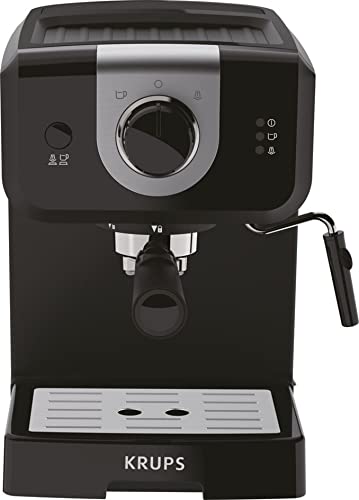How to Properly Maintain and Clean an Espresso Coffee Machine
Espresso machines push water through the coffee grounds by using pressure. This method of brewing produces stronger beverages than drip coffee. These machines require nine bar of pressure in order to extract the flavor from the ground.
There are three kinds of espresso machines. They are manual, semiautomatic and fully automated. Semiautomatic machines permit you to regulate grinding, tamping and extraction time. They offer a great balance between human control and mechanised accuracy.
Easy to use
The best espresso machines have an easy-to-use interface. They feature an adjustable thermostat that keeps water at the right temperature and a pressure-pump that increases the amount water per shot. The increased pressure makes the grounds dissolve more quickly and produces a creamy crema with the perfect consistency. They also have a milk mixer to make espresso-based drinks like lattes or cappuccinos.
The traditional steam-driven electric machines utilize an airtight tank that warm water until it reaches boiling, and then release the pressure to create a shot of espresso. They are small and cost-effective however they only allow 1-2 bar of pressure. This is less than the ideal 9 bar for espresso.

Semi-automatic espresso machines function by infusing hot water into an already-ground, pre-tamped portafilter of beans. The barista is in charge of the extraction process, but has to manually measure grind, grind and then tamp each cup of beans. check out the post right here is more expensive, but it gives you more control and stability. Jai from Blank Street Cafe says.
Full-automatic espresso machines take out the barista from the espresso brewing process, making them much easier to use than semi-automatic models. Most come with built-in grinders that are connected to the portafilter. They then automatically grind and dosing the beans and can be adjusted to produce different drinks. Some machines come with the capacity to foam milk and then pour it out for you.
Easy to clean
Espresso machines make a stronger fuller-bodied shot making use of more heat and pressure than drip coffee makers. They also come with a milk frothing system, which allows you to make cappuccinos and lattes. They require more maintenance than drip machines, such as regular cleaning and descale. The good news is that most espresso machines are easy to clean. A few of the models on our list were specifically designed to make cleaning simpler.
Most espresso machines have the portafilter, which stores the grounds of coffee during brewing. Some models feature a grouphead which is a collection of components that actually perform the extraction. Backflushing your machine regularly will keep these components clean and free of gunk and grit. This means cleaning and brushing the portafilter, locking it, and running the brew cycle multiple times. Backflushing is done daily in a lot of coffeehouses, however at home, it should be done once every week.
Filtering or soft water is recommended as this will help reduce the amount of mineral buildup and reduce your need to descale. It is crucial to remember that a moderate amount is required to extract. Too much mineral will overwhelm the taste. Too little could result in weak, salty coffee. Maintaining your machine will ensure that it continues to function well and taste fantastic for as long as you own.
Easy to maintain
An espresso machine is a magnificent piece of equipment that lets you to serve a broad variety of coffee drinks. A carafe coffee maker can achieve the same result, but an espresso machine needs greater pressure and temperatures. To achieve this, the machine must be maintained and cleaned regularly. Fortunately, you don't need to be an expert to keep your espresso machine operating smoothly.
You'll want to clean the gasket every week. This is where coffee oils collect and can cause the bitter taste of coffee that is rancid. To do this, backflush the group using a solution of water and espresso machine cleaner. You should also clean your screen including the nooks and crevices using a toothbrush made of nylon or Coffeetool.
It's also important to wash the drip tray daily because it collects coffee waste from each brew cycle. It can also become a perfect breeding ground for mold and bacteria, which can affect the taste of your coffee. You should also clean the exterior of your machine frequently to avoid the build-up of milk residue and coffee.
Take a look at a milk system cleanser designed to clean all components that come in contact with milk. These products are sold in most grocery stores and are easy to use.
Repairable and simple
A coffee maker or espresso maker is a valuable appliance for your home or office. But, as with any electrical appliance, it could malfunction from time to time. This can be frustrating if your espresso or coffee machine ceases to function. Fortunately, most of these issues can be fixed easily. In most cases, they are caused by a simple error or poor maintenance.
First, make sure that the machine is connected and turned on. It is also essential to check the water tank for blockages or clogs. If the problem persists it may be necessary to contact an expert technician.
Coffee and espresso machines could encounter a myriad of issues, including no power and heating, damaged steam wands or an inability to create enough pressure. These issues are usually easily resolved, but others require more detailed troubleshooting and cleaning. These tasks should be carried out with extreme care and caution as many components are delicate and can be damaged easily.
Get help from a professional if are unsure of how to repair your espresso or coffee machine to avoid costly repairs. It is also important to use proper tools and follow the procedures whenever you repair espresso or coffee machines. Also, be aware that certain brands require that their coffee or espresso machines be serviced by a certified national repair center.
